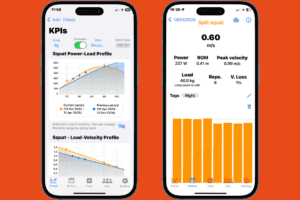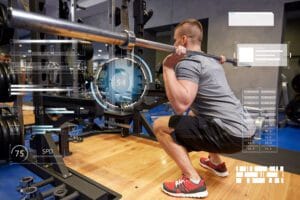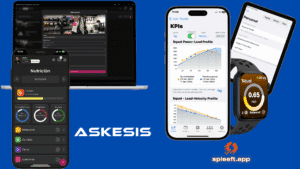Cuando se trata de mejorar el rendimiento atlético y la salud física en general, la flexibilidad muscular a menudo pasa a un segundo plano frente a la fuerza, la flexibilidad y la resistencia. Sin embargo, la flexibilidad muscular está surgiendo como un factor crucial que une todos estos atributos. No se trata solo de ser flexible o móvil; se trata de tener músculos que sean adaptables, resistentes y capaces de manejar las demandas de la vida diaria y el entrenamiento. Entonces, ¿qué es exactamente la flexibilidad muscular y cómo puedes beneficiarte de incorporar el entrenamiento de flexibilidad a tu rutina? [3]
En este blog, se analizan la definición, los beneficios y las estrategias prácticas para mejorar la flexibilidad muscular con el fin de mejorar el rendimiento, prevenir lesiones y optimizar la recuperación. A lo largo del camino, profundizaremos en consejos prácticos que ayudarán a los atletas, entusiastas del fitness e incluso principiantes a descubrir su verdadero potencial. [4]
¡DESCARGA LA APLICACIÓN SPLEEFT AHORA PARA iOS, ANDROID Y APPLE WATCH!
Flexibilidad y rendimiento muscular
¿Qué es la flexibilidad muscular?
La flexibilidad muscular se define como la cualidad de los músculos de ser suaves, largos y resistentes, lo que les permite adaptarse de manera eficiente a las fuerzas externas. Representa la capacidad de los tejidos musculares de absorber y dispersar la energía de manera segura, lo que los hace menos propensos a sufrir lesiones y con una mejor recuperación. [5]
En términos simples, la flexibilidad combina flexibilidad, movilidad y fuerza. Un músculo flexible puede estirarse y contraerse en todo su rango de movimiento (ROM) mientras mantiene su integridad estructural. Esta adaptabilidad es fundamental para los atletas que participan con frecuencia en actividades de alta intensidad, así como para el individuo promedio que desea moverse mejor y sentirse más saludable. [2][1]

Flexibilidad vs. flexibilidad y movilidad
Es fácil confundir la flexibilidad con la flexibilidad o la movilidad, ya que estos términos suelen usarse indistintamente. Sin embargo, cada uno tiene características distintivas:
- Flexibilidad: Se refiere al rango pasivo de movimiento de una articulación. Por ejemplo, hasta dónde se pueden estirar los isquiotibiales sin involucrar activamente los músculos. [1]
- Movilidad: Describe el rango de movimiento activo, que involucra fuerza y control muscular. Piense en ponerse en cuclillas mientras mantiene las rodillas estables y alineadas. [2]
- Flexibilidad: Va más allá de la flexibilidad y la movilidad al incorporar la salud de los tejidos, el flujo sanguíneo y la capacidad de adaptarse bajo tensión. Mientras que la flexibilidad y la movilidad se centran en el movimiento, la flexibilidad garantiza que los músculos sigan siendo duraderos, absorban las fuerzas de manera eficaz y se recuperen de manera óptima. [8]
La ciencia detrás de la flexibilidad muscular
El concepto de flexibilidad ha ganado atención recientemente, en parte debido al “Método TB12” de Tom Brady, que enfatiza la flexibilidad como la piedra angular de su éxito duradero en la NFL. La idea se basa en mantener la salud muscular a nivel celular. [2][7]
Los músculos flexibles tienen mejor circulación sanguínea, mejorado consumo de oxígeno, y mejorado eficiencia neuromuscularEsto conduce a una recuperación más rápida, una menor rigidez y una mayor capacidad de producción de fuerza y absorción de energía. [6]
Investigación publicada en la Revista de rehabilitación deportiva Destaca que técnicas como el uso de rodillos de espuma, combinadas con estiramientos estáticos, mejoran significativamente el rango de movimiento (ROM). Este aumento del ROM es uno de los indicadores de una mayor flexibilidad muscular, lo que ayuda a los atletas a lograr una mejor calidad de movimiento y, al mismo tiempo, reduce el riesgo de lesiones. [1]
Por qué es importante la flexibilidad muscular
La flexibilidad afecta todos los aspectos del rendimiento físico y el bienestar general. A continuación, se analiza en detalle por qué es tan importante:
1. Prevención de lesiones
Los músculos flexibles pueden absorber los impactos y distribuir las fuerzas de manera más uniforme, lo que reduce la tensión en las articulaciones y los tejidos conectivos. Para los atletas, esto significa menos desgarros musculares, esguinces y lesiones por uso excesivo.
2. Rendimiento mejorado
Los músculos flexibles permiten una contracción y relajación completas, lo que permite una mayor producción de fuerza y resistencia. Ya sea que se trate de correr, levantar objetos o realizar movimientos explosivos, la flexibilidad le ayuda a hacerlo mejor.
3. Recuperación optimizada
Al promover un mejor flujo sanguíneo y suministro de oxígeno, la flexibilidad acelera la recuperación muscular, algo esencial para cualquier persona que realice un entrenamiento intenso o actividades físicas exigentes.
4. Mayor flexibilidad y movilidad
La flexibilidad favorece y mejora la flexibilidad y la movilidad, garantizando que sus músculos puedan moverse de manera eficiente sin comprometer la estabilidad o el control.
5. Salud a largo plazo
Para quienes no son deportistas, la flexibilidad reduce la probabilidad de sufrir problemas crónicos como dolor de espalda, rigidez y molestias en las articulaciones. Garantiza que puedas moverte con libertad y comodidad a medida que envejeces.
Cómo mejorar la flexibilidad muscular

Para desarrollar músculos flexibles se necesita una combinación de actividades físicas, cambios en el estilo de vida y técnicas de recuperación adecuadas. A continuación, se presentan estrategias prácticas que le ayudarán a mejorar la flexibilidad muscular.
1. Rodillo de espuma
El uso del rodillo de espuma, también conocido como autoliberación miofascial, es una de las herramientas más eficaces para mejorar la flexibilidad. Ayuda a liberar la tensión en los músculos tensos, a romper las adherencias en la fascia y a mejorar el flujo sanguíneo a las zonas objetivo. El uso del rodillo de espuma se puede realizar antes del entrenamiento para preparar los músculos para el movimiento o después del entrenamiento para ayudar a la recuperación.
Cómo utilizar un rodillo de espuma de manera eficaz:
- Realizar 2-3 series por grupo muscular.
- Haga rodar cada área lentamente durante 30 a 60 segundos.
- Concéntrese en los puntos estrechos, pero evite rodar directamente sobre las articulaciones.
La combinación del uso del rodillo de espuma con el estiramiento dinámico mejora sus beneficios, como lo respalda la investigación de Revista de rehabilitación deportiva. [3]
2. Terapia de masajes
La terapia manual, como el masaje de tejido profundo, es un método más práctico para mejorar la flexibilidad muscular. Funciona liberando los nudos tensos y aumentando la circulación sanguínea, lo que promueve la recuperación y mejora la flexibilidad. Los masajes regulares también reducen la rigidez muscular y mejoran el rango de movimiento, lo que los convierte en un valioso complemento a su régimen de flexibilidad.
3. Estiramiento dinámico y estático
Los estiramientos son fundamentales para mantener y mejorar la flexibilidad. Sin embargo, el tipo de estiramiento que se realiza es importante.
- Estiramiento dinámico: Los estiramientos dinámicos son ideales para calentar antes de hacer ejercicio y consisten en movimientos activos que imitan la actividad que se va a realizar. Algunos ejemplos son balanceos de piernas, círculos con los brazos y estocadas caminando.
- Estiramiento estático: Más adecuados para la recuperación posterior al entrenamiento, los estiramientos estáticos implican mantener el estiramiento durante 20 a 30 segundos para alargar los músculos y aliviar la tensión.
Evite los estiramientos estáticos prolongados antes de los entrenamientos, ya que pueden reducir temporalmente la fuerza muscular. [2]
4. Hidratación adecuada
Los músculos contienen aproximadamente 75% de agua. La deshidratación puede provocar una menor elasticidad muscular, una recuperación deficiente y un mayor riesgo de lesiones. Para mantener una hidratación óptima:
- Beba agua constantemente durante todo el día.
- Incorpore bebidas ricas en electrolitos después de entrenamientos intensos para reponer los minerales perdidos.
5. Nutrición para la flexibilidad
Alimentar el cuerpo con los nutrientes adecuados es esencial para la salud muscular. Una dieta rica en proteínas magras, grasas saludables y carbohidratos complejos proporciona los elementos básicos para la reparación y el crecimiento muscular. Los micronutrientes como el magnesio y el potasio también favorecen la elasticidad y el funcionamiento de los músculos.
Integración de la aplicación Spleeft para el seguimiento de la flexibilidad
Para aquellos que desean llevar su flexibilidad muscular al siguiente nivel, la aplicación Spleeft ofrece una solución única. Al aprovechar los datos del entrenamiento basado en la velocidad (VBT), la aplicación lo ayuda a monitorear la calidad de sus movimientos musculares durante varios ejercicios. La flexibilidad juega un papel fundamental para mantener una velocidad óptima durante los ejercicios de fuerza y potencia, y Spleeft puede rastrear las tendencias para garantizar que sus músculos funcionen de manera eficiente. [7]
Incorpora la aplicación Spleeft para:
- Monitorizar la recuperación y la preparación en función de la velocidad del ejercicio.
- Identifica los puntos débiles en tu rango de movimiento (ROM).
- Ajuste los programas de entrenamiento para mejorar la flexibilidad y el rendimiento.
Esta integración no solo simplifica el seguimiento, sino que también proporciona información útil adaptada a sus necesidades específicas.
Estrategias avanzadas para mejorar la flexibilidad muscular
Para optimizar realmente la flexibilidad de tus músculos, debes ir más allá de los conceptos básicos e incorporar técnicas avanzadas a tu rutina. Estos métodos pueden mejorar aún más la salud de tus músculos, ayudarte a identificar los puntos débiles y garantizar que rindas al máximo.
1. Ejercicios de fuerza y acondicionamiento
Contrariamente a la creencia de que la flexibilidad se basa únicamente en el estiramiento y la relajación, el entrenamiento de fuerza desempeña un papel importante en el desarrollo de músculos flexibles. Incorporar ejercicios de resistencia controlada a través de un rango completo de movimiento garantiza que los músculos se mantengan fuertes, adaptables y capaces de absorber fuerzas de manera eficaz.
Ejercicios clave para la flexibilidad:
- Entrenamiento excéntrico: Concéntrese en la fase de descenso de movimientos como sentadillas o levantamientos de peso muerto para alargar los músculos bajo tensión.
- Retenciones isométricas: Ejercicios como sentadillas contra la pared o planchas mejoran la eficiencia neuromuscular y la estabilidad general.
- Trabajo con una sola pierna: Movimientos como las sentadillas divididas búlgaras o los levantamientos de peso muerto rumanos con una sola pierna exponen los desequilibrios y ayudan a abordar las debilidades.
El entrenamiento de fuerza también complementa la flexibilidad al promover síntesis de colágeno, mejorando la elasticidad muscular y mejorando la resistencia del tejido conectivo.
2. Incorporar días de recuperación activa
La recuperación activa implica actividades de baja intensidad que promueven el flujo sanguíneo y ayudan a reducir la rigidez muscular sin sobrecargar el sistema. Estas sesiones le permiten mantener el impulso y, al mismo tiempo, le dan a su cuerpo el tiempo que necesita para recuperarse y adaptarse.
Ejemplos de actividades de recuperación activa:
- Ciclismo ligero o caminar.
- Yoga o Pilates, centrándose en movimientos controlados y fluidos.
- Rutinas de estiramiento dinámico.
Los días de recuperación activa son especialmente útiles para deportistas o personas que van al gimnasio y entrenan varias veces por semana. Garantizan que los músculos se mantengan flexibles, lo que ayuda a recuperarse más fuerte para el próximo entrenamiento.
3. Sueño y recuperación para la flexibilidad
El sueño es una actividad que a menudo se pasa por alto, pero es fundamental para la flexibilidad muscular. Durante el sueño profundo, el cuerpo entra en un modo de reparación que permite que los tejidos se reconstruyan, la inflamación disminuya y los sistemas neuromusculares se restablezcan. La falta de sueño puede perjudicar la recuperación, aumentar la rigidez y afectar negativamente la flexibilidad.
Consejos para maximizar la calidad del sueño:
- Mantenga un horario de sueño constante.
- Mantenga su habitación oscura y fresca para obtener condiciones óptimas.
- Evite la exposición a la luz azul de las pantallas 1 a 2 horas antes de acostarse.
- Incorpore técnicas de relajación, como meditación o estiramientos ligeros, antes de dormir.
Un sueño de calidad es esencial para mantener la flexibilidad, ya que garantiza que los músculos permanezcan suaves, resistentes y listos para el movimiento.
4. Técnicas avanzadas de terapia manual
Además del masaje tradicional, existen métodos avanzados de terapia manual que se centran en la flexibilidad muscular:
- Técnicas de liberación activa (ART): Se centra en romper el tejido cicatricial y las adherencias, mejorando la longitud y la función muscular.
- Terapia con ventosas: Utiliza succión para aumentar el flujo sanguíneo a las áreas tensas, reduciendo la rigidez y mejorando la recuperación.
- Terapia de liberación miofascial: Se enfoca en las restricciones del tejido conectivo para mejorar el rango de movimiento y la flexibilidad muscular.
Programar sesiones regulares con un terapeuta capacitado puede ayudar a abordar la rigidez crónica y mejorar la flexibilidad con el tiempo.
El papel de la nutrición en la flexibilidad muscular
La nutrición alimenta cada aspecto de la recuperación y el rendimiento del cuerpo, incluida la flexibilidad muscular. A continuación, se muestra cómo los componentes dietéticos específicos pueden mejorar la flexibilidad:
- Proteína: Favorece la reparación muscular y la producción de colágeno, dos elementos esenciales para la flexibilidad. Opte por proteínas magras como pollo, pescado, huevos y opciones vegetales como lentejas o tofu.
- Ácidos grasos omega-3: Los omega-3, presentes en el salmón, las nueces y las semillas de lino, reducen la inflamación y favorecen la salud de los tejidos.
- Antioxidantes: Alimentos como las bayas, las espinacas y el chocolate negro combaten el estrés oxidativo, promoviendo la recuperación y la flexibilidad.
- Magnesio: Este mineral, que se encuentra en frutos secos, semillas y verduras de hojas verdes, ayuda a relajar los músculos y mejorar la flexibilidad.
- Hidratación: Además del agua, incluya bebidas ricas en electrolitos o frutas como sandía y naranjas para favorecer el funcionamiento óptimo de los músculos.
Cómo la aplicación Spleeft puede revolucionar el entrenamiento en flexibilidad
A medida que trabaja para mejorar la flexibilidad muscular, es fundamental realizar un seguimiento de su progreso y asegurarse de que sus músculos funcionen de manera eficiente. Aquí es donde entra en juego la aplicación Spleeft. Al utilizar métricas avanzadas de entrenamiento basado en la velocidad (VBT), Spleeft brinda información útil sobre el rendimiento y la recuperación de sus músculos.
Así es como Spleeft respalda los objetivos de flexibilidad:
- Información sobre la velocidad: Realice un seguimiento de cómo la flexibilidad muscular afecta su rendimiento deportivo. Por ejemplo, unos músculos más rígidos pueden provocar una velocidad de la barra más lenta durante las sentadillas o los levantamientos de peso muerto. Spleeft identifica estas tendencias y le ayuda a ajustar su entrenamiento.
- Monitoreo de ROM: Utilice la aplicación para medir y optimizar el rango de movimiento (ROM) durante los ejercicios, garantizando que sus esfuerzos de flexibilidad se traduzcan en una mejor calidad de movimiento.
- Comentarios de recuperación: La flexibilidad favorece la recuperación y las métricas de preparación de Spleeft te permiten saber cuándo tus músculos están preparados para otro entrenamiento intenso.
- Programas personalizados: La aplicación ofrece recomendaciones personalizadas de ejercicios como rodillos de espuma, estiramientos y calentamientos dinámicos para maximizar la flexibilidad.
Integrar Spleeft en su rutina cierra la brecha entre la retroalimentación subjetiva y los datos objetivos, garantizando que sus esfuerzos produzcan resultados mensurables.
Los beneficios de la flexibilidad muscular: un breve resumen
A estas alturas, está claro que la flexibilidad muscular ofrece una serie de beneficios para todos, desde los deportistas hasta las personas que simplemente buscan moverse mejor y sentirse más saludables. A continuación, se incluye un breve resumen:
- Prevención de lesiones: Los músculos flexibles absorben los impactos y distribuyen las fuerzas de manera uniforme, lo que reduce el riesgo de distensiones y desgarros.
- Rendimiento mejorado: Una mejor eficiencia neuromuscular y un mejor rango de movimiento permiten movimientos más fuertes y explosivos.
- Recuperación acelerada: El flujo sanguíneo y la oxigenación mejorados reducen el dolor y aceleran la reparación de los tejidos.
- Longevidad: Mantiene la salud y la movilidad muscular a medida que envejece, garantizando un movimiento funcional y sin dolor.
- Entrenamiento optimizado: Favorece una mejor técnica, lo que permite levantar más peso y entrenar más duro con menor riesgo.
Reflexiones finales: hacer de la flexibilidad una prioridad
La flexibilidad muscular es más que un término de moda en el mundo del fitness: es un componente fundamental de la salud y el rendimiento físico general. Si integras técnicas como el uso de rodillos de espuma, una hidratación adecuada, estiramientos dinámicos y estrategias de recuperación avanzadas, puedes mejorar significativamente tu flexibilidad muscular.
Para aquellos que buscan llevar su entrenamiento al siguiente nivel, herramientas como la aplicación Spleeft brindan retroalimentación en tiempo real y conocimientos personalizados, lo que lo ayuda a alcanzar sus objetivos de flexibilidad de manera más rápida y efectiva.
Ya sea que sea un atleta, un entusiasta del fitness o alguien que simplemente quiere moverse mejor, priorizar la flexibilidad muscular desbloqueará todo el potencial de su cuerpo y lo preparará para el éxito a largo plazo.
Referencias
- Vive Recovery Center. (2023). “¿Qué es la flexibilidad muscular y por qué es importante?”
- TB12 Sports. (2023). “La importancia de la flexibilidad muscular”.
- Access Sports Medicine. (2023). “¿Qué es la flexibilidad y por qué es importante?”
- Fitness Volt. (2023). “La flexibilidad y su importancia para el bienestar”.
- Land, LD y McGowan, CJ (2013). “Los efectos del masaje de tejido profundo sobre la densidad muscular y la flexibilidad en personas con dolor lumbar crónico”. Revista de fisioterapia ortopédica y deportiva, 43(9), 625-633.
- Moller, M., y Lindström, L. (1985). “Propiedades viscoelásticas del músculo esquelético humano durante el estiramiento estático”. Revista escandinava de medicina de rehabilitación, 17(1), 3-8.
- Kobayashi, Y., y Matsuyama, D. (2024). “Medición de los cambios en la viscoelasticidad muscular durante el estiramiento estático utilizando datos de relajación por estrés”. preimpresión de arXiv arXiv:2401.13217.
- Remeniéras, J.-P., Bulot, M., Gennisson, J.-L., Patat, F., Destrade, M. y Bacle, G. (2021). “Acústico-elasticidad de tejidos blandos incompresibles transversalmente isotrópicos: caracterización del músculo estriado esquelético”. preimpresión de arXiv arXiv:2103.09152.

Iván de Lucas Rogero
Aplicación de rendimiento físico y CEO de MSC
Dedicado a mejorar el rendimiento atlético y el entrenamiento ciclista, combinando ciencia y tecnología para impulsar resultados.





